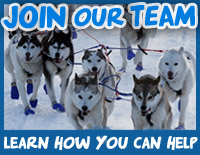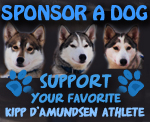ANADYR SIBERIAN HUSKIES
© 1996 by Bob and Pam Thomas
Five decades -- 50 years -- half a century! No matter how you add it up, it is a truly remarkable achievement in the history of our breed. From the first litter in 1946 right up to the training of the current Alaskan Kennel Iditarod team, Earl and Natalie Norris have become synonymous with outstanding Siberian sled dogs. There has never been a Siberian kennel active for such a long span of time, and probably never will be again.
The Norrises have literally devoted their lives to the goal of improvement in performance of the Siberian while still retaining type. The revival of the Siberian in Alaska after World War II is solely the result of their efforts. During the late 1950s, through the 70s when most other long time Siberian mushers turned at least partly to the Alaskan Husky, Earl and Natalie stayed with their beloved Siberians, ensuring that we would have world class Siberian sled dogs today. For this loyalty to the breed, Siberian dog mushers now and in the future will always be indebted. This special issue is our way of saying thanks for all they have done.
EARL
Earl actually established his 'Alaskan' kennel name in Idaho in 1936. With the entrance of the U.S. into World War II in 1942, Earl managed to get a position in Alaska with the Civil Aeronautics Administration which was constructing airfields and navigation facilities around Alaska. Earl homesteaded just outside Anchorage and built up a small kennel of Alaskan Malamutes. (Today the homestead has been swallowed up by the city - the University Mall area just east of Anchorage's public library sits on the original homestead) By 1950 Earl was Director of Logistics for the Port of Anchorage and working downtown. He remembers that in the years after World War II, he often drove the dog team to work, Anchorage being much smaller than it is now!
NATALIE
Natalie Jubin was born in Lake Placid, NY in 1924 and by age 12 had her own team of sled dogs of mixed heritage. Lake Placid had a history of sled dog use dating back to World War I when the practice of hauling tourists by dog team originated. The first annual Lake Placid sled dog race was held in 1928 and many New England mushers attended, including Leonard Seppala. When World War II ended, Natalie worked for Short Seeley at Chinook Kennels, Wonalancet, NH. She had the opportunity to run in harness such dogs as Champion Wonalancet's Baldy of Alyeska, Champion Wonalancet's Disco of Alyeska and Waska. In the fall of 1945, Natalie decided that Alaska was the place she wanted to be. Short selected two Siberians from Chinook Kennel for Natalie to take with her and her other dogs. In early 1946 Natalie set out with her dogs and very little money. Fortunately, however, Earl Norris knew she was coming after seeing an article about Natalie and how she planned to emigrate to Alaska in a syndicated Sunday newspaper magazine titled 'This Week .' He had written to her before she left New Hampshire, advising her that he would be available to help her get settled in Alaska. So it came to pass that Natalie's wayward troop settled in with Earl's dogs at his homestead just outside Anchorage.
At this point in Alaska, 1946, no one was breeding Siberians, so Earl and Natalie immediately embarked on a breeding program. One of the dogs selected by Short Seeley, Terry, a half-brother to Aladdin, was not used due to an illness from which he never fully recovered. The other male, however, would be the foundation of what would become the greatest modern Siberian kennel in Alaska. Chinook's Aladdin of Alyeska, born May 9, 1944, was out of Czar of Alyeska and T-cheeakio of Alyeska. After placing third in the 1946 Fur Rondy, Earl won the 1947 race with Natalie's Malamute bitch, Suggen, in lead. In 1950, the Fur Rondy expanded to four heats of 25 miles each. In 1951, Earl's team - once again Aladdin leading a team of his own offspring - set a track record on the fourth heat of 1 hour, 39 minutes, 27 seconds, averaging 15.08 miles per hour. The record would stand until 1962 when the renowned George Attla bested it in a race which had been reduced to 3 heats of 25 miles each. It should also be pointed out that Earl set the record with a 9-dog team - Attla had 16. It appears that 'Short' had selected one heck of a dog for Natalie! Aladdin ran single lead for Earl in every race he entered between 1948 and 1953.
Also during the late 1940s to the early 1960s, Earl and Natalie were instrumental in the initial organization of several sled dog clubs in Alaska. In addition to Earl's role in the first Anchorage Fur Rendezvous, Earl and Natalie became charter members of the Alaska Dog Mushers' Association. (ADMA) in 1945, which holds the North American Championships each year in Fairbanks. In 1949, Earl was instrumental in the foundation of the Alaska Sled Dog Racing Association (ASDRA), which took responsibility for the Fur Rendezvous race. Natalie was the editor for the first Fur Rondy magazine as well.
The Norrises were also largely responsible for the 1949 founding of the Alaska Kennel Club, which brought the first dog shows to Alaska, and the formation of the Siberian Husky Club of Alaska. This club held the first independent Siberian Husky Club specialty show - ever - in 1956. The entry of 32 Siberians was the largest in an AKC show to that date.
Vixen of Anadyr was bred to Alyeska's Sugrut of Chinook and whelped the fastest dog Earl and Natalie have ever owned - Alaskan's Nicolai of Anadyr. Nicolai ran single lead and Earl says he was never able to buy a dog, of any background, who could run with him - so, Nicolai had to produce his own competition, and was bred to Alaskan's Bon-Bon of Anadyr to produce Alaskan's Astro of Anadyr, a promising young dog, in 1965. Tragically, Nicolai got loose and onto the highway where he was killed by a car.
Astro was a piebald and the main Siberian leader through the late 1960s and into the 70s. In 1970, in fact, Astro led Natalie's team to win at the Women's Open North American Championships in Fairbanks. On that same team was one of Astro's offspring, a 2 year old black and white male out of Alaskan's Sestra of Anadyr, II - Alaskan's Nicolai of Anadyr II. This young dog would go on to outshine Astro, Nicolai, and Bonzo as that greatest Siberian ever produced by Earl and Natalie, and arguable the greatest Siberian leader of modern sled dog racing.
Nicolai II lived a long life and was able to sire many good dogs over the years. This enabled the Norrises to shrink the size of their kennel as the Nic II gene pool produced a good percentage of outstanding dogs.
The Norrises have always bred heavily on their leaders as they naturally were the fastest and most aggressive running dogs. As a result, the percentage of Alaskan/Anadyr Siberians with lead ability is very high. This trait showed itself to be useful with the fundamental shift from sprint racing to longer distance racing, which began with the first Iditarod in 1973. The need to have several reliable lead dogs on a team made the Norris Siberians, Nicolai II offspring in particular, valuable dogs to have.
The Norrises are world renowned for their assistance to novice mushers who want to winter over in Alaska and learn the craft. This apprentice-like program became very popular with the growth of the Iditarod race. Quite a few mushers have run Anadyr Siberians in the Last Great Race, including Martin Buser (twice).
The first Iditarod was held in 1973 and a fundamental change in racing in Alaska was soon to take place. Harkening back to the All-Alaska Sweepstakes dogs, mushers desired to test their teams in longer races. Earl and Natalie's association with the Iditarod began in 1975, the 3rd running of the "Last Great Race." Chris Camping, a Canadian, ran a team of Alaskan/Anadyr Siberians. That experience has since led to a total of 11 teams completing the race with primarily Anadyr dogs. All the teams, except one (Earl's personal 1985 team) have been driven by mushers who spent the season(s) at Willow, training the dogs, racing in preliminary races, and finally tackling the Iditarod. In 1980 and 81, Martin Buser of Switzerland ran Alaskan/Anadyr teams, getting him started on one of the most notable dog mushing careers in Alaska. Martin has gone on to win the Iditarod in 1992 and 1994. As far as Earl and Natalie are concerned, their favorite Iditarod musher would have to be Kari Skogen of Norway, who completed the race in 1984 and 1986 with Alaskan/Anadyr teams. This would be of course, because Kari subsequently married Earl and Natalie's son, J.P.! Earl ran the Iditarod in 1985 himself. It's claim to fame was the worst weather one could imagine, but Earl finished 31st despite torn ligaments in his knee suffered early in the race which eventually slowed him down.
Both Earl and Natalie have been in great demand as a result of their immense knowledge of the breed. Natalie has been an AKC licensed judge of Siberians for some time now. She always appears on everyone's short list of breeder-judges. Natalie is one of the few judges with extensive racing qualifications, so her view of the show ring is one that almost all exhibitors are interested in. People are honored to show their Siberian to Natalie, and she draws good entries.
Earl and Natalie are two of the few who knew the pioneers. Fortunately, Earl had, for some time, studied the history of sled dog racing, especially in Alaska and had given seminars that combine history with sled dog training. Both he and Natalie have traveled all over the world to present this knowledge to interested fanciers. Earl amassed a large collection of sled dog memorabilia, books, photographs and equipment.
Credit is given to Bob and Pam Thomas of No-Kita Siberian Huskies
Some of today´s active kennels, using Anadyr bloodlines in their breeding programs:
KIPP D´AMUNDSEN - Sweden
VARGEVASS - Norway
NORTH WAPITI - Canada
JEDYE - USA
COASTRUNNERS - Finland




